Testing the Intel® Storage System JBOD 2000 Family Shelf
Just recently, I happened to test a disk shelf from Intel . “It would seem that what could be surprising in a regular disk shelf,” I thought, but after a detailed review the regiment was not quite typical. Actually, I'll tell you about it.
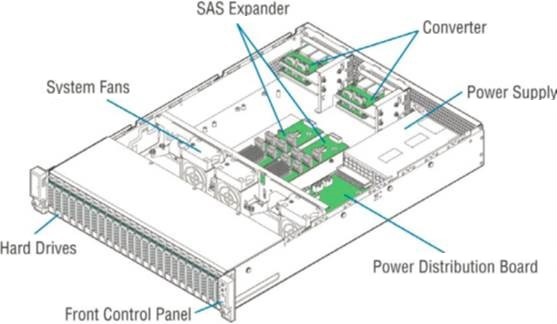
Intel Storage System JBOD 2000 Family is not just a storage system or a disk shelf, it is a full DAS (Direct Attach Storage).
The devices have the ability to connect a couple of servers to the same shelf (as well as a cascade of shelves), which allows you to organize a two-node cluster . The vendor calls such a scheme - Dual SAS Domain Clustered Cascaded .
Basically, these disk systems use the Intel Server System R2000GZ / GL server platform chassis - this reduced Intel's development costs for the shelf and had a beneficial effect on its final cost. In addition, this JBOD was very difficult to distinguish from the server.
')
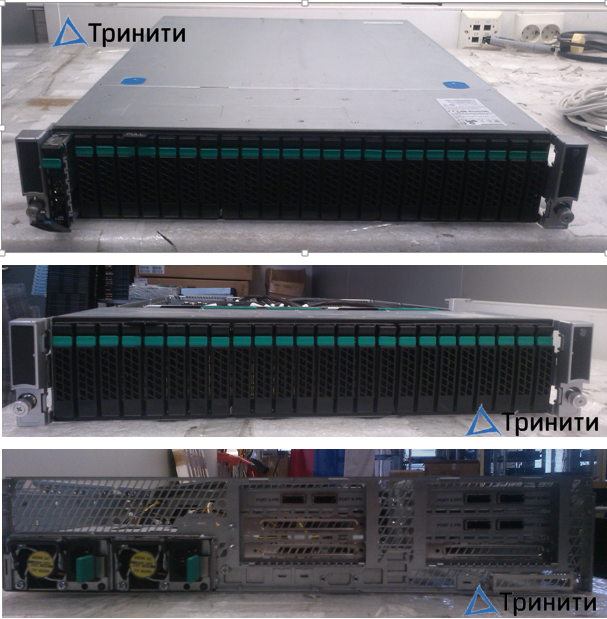
Intel Storage System JBOD2224S2DP:
• 3x backplanes with 8x 2.5 "disks (only 24 disks per shelf)
• 2x 36 Port Expanders for fault tolerance and access to SAS drives
• 2x power supply for 460W each With redundancy on 1 + 1 system
• 3x 10 ”Fan for chassis and disk cooling
• 2x SAS Converter Primary External, Secondary External)
• 1x SAS Cascading Shelf Out
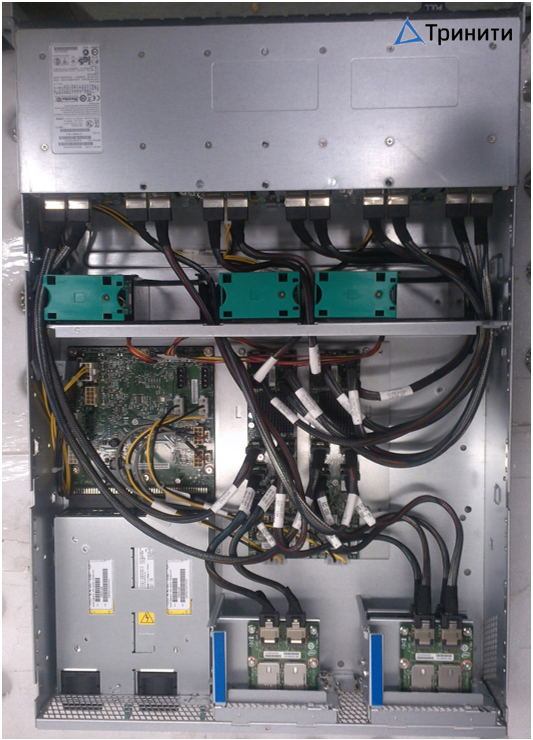

In this shelf, a maximum of 24 disks can be installed, but there are two 36 port SAS expander, why do you ask so much, because 2 to 36 is 72, and we have a maximum of 24 disks? It's very simple, SAS drives include 2 ports (2 lines) of data exchange. Accordingly, one line goes to the first controller, and the second to the second. Thus, we accelerate data access and protect ourselves in case of failure of one of the controllers.
But for a SATA disk, one controller is enough; SATA drives have only one data line. Also, the shelf has two power supplies and a Power Distribution Board with redundant power supplies on a 1 + 1 system, i.e. the system will work if one of the power supplies fails. In addition, each power supply has a hot-swap feature and can be replaced without stopping the system. SAS converters in essence serve as adapters from internal SFF 8087 to external SFF 8088 for connecting to server controllers.
Testing was performed in a fail-safe file cluster configuration of 2 servers and one disk shelf, which provides continuous access to data when one of the SAS channels fails or one of the servers fails.
Two types of 2.5 inch disks were used for testing, namely: 4xSSD Intel DC S3700 Series (100GB, 2.5in SATA 6Gb / s, 25nm, MLC), 4xHDD Hitachi C10K900 300GB (2.5 ", SAS, 10k rpm).

Consider the simplest configurations, such as RAID 0 and RAID 1 with 2 disks in each array.
First, look at the SSD :
RAID 0 Example with 2x SSD
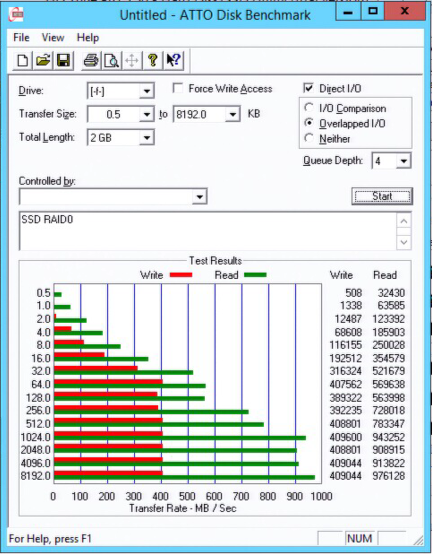
RAID 1 example on 2x SSD
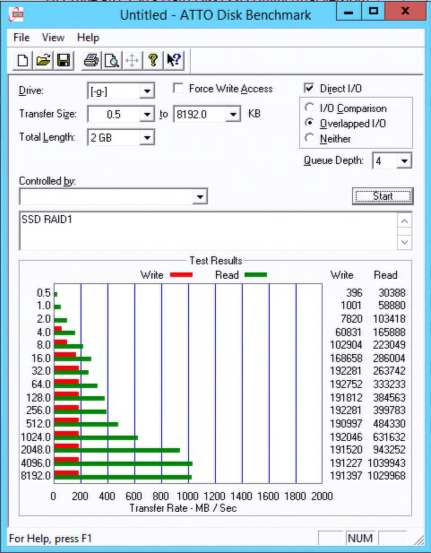
Let's look at SAS disks:
RAID 0 example on 2x SAS drives
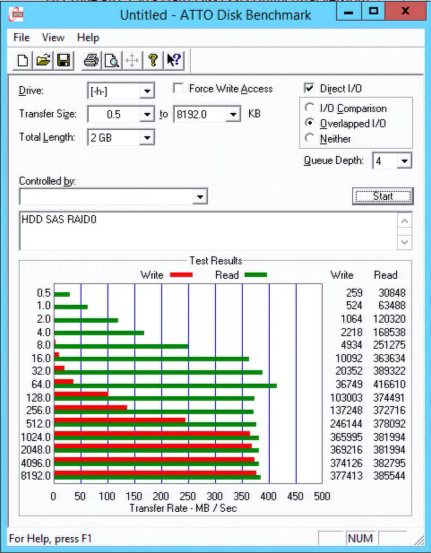
RAID 1 example on 2x SAS drives

Now consider a more complex configuration, namely a RAID 6 volume from 4xSAS drives and 4xSATA SSD:
RAID 6 example on 4x SSD

RAID6 example on 4x SAS disks
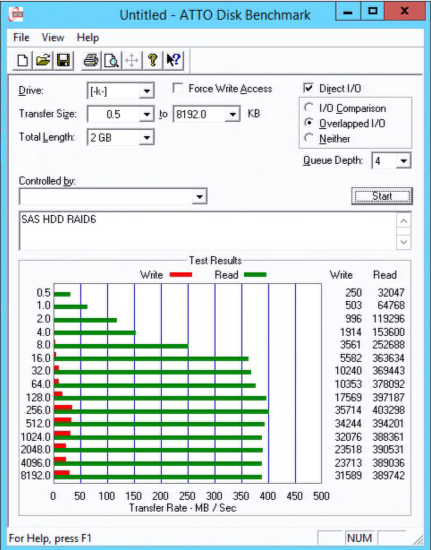
In conclusion, I note that these shelves are very competitive product both in price and quality. An important advantage is the ease of implementation, and good scalability due to the possibility of cascading. Support for high-speed SAS / SATA 6 Gb / s drives and a relatively small 2U size allows you to increase the maximum possible disk density in any data center or office server.

Why do we need disc shelves and what they eat
Intel Storage System JBOD 2000 Family is not just a storage system or a disk shelf, it is a full DAS (Direct Attach Storage).
The devices have the ability to connect a couple of servers to the same shelf (as well as a cascade of shelves), which allows you to organize a two-node cluster . The vendor calls such a scheme - Dual SAS Domain Clustered Cascaded .
Basically, these disk systems use the Intel Server System R2000GZ / GL server platform chassis - this reduced Intel's development costs for the shelf and had a beneficial effect on its final cost. In addition, this JBOD was very difficult to distinguish from the server.
')
Now about the inner world
Intel Storage System JBOD2224S2DP:
• 3x backplanes with 8x 2.5 "disks (only 24 disks per shelf)
• 2x 36 Port Expanders for fault tolerance and access to SAS drives
• 2x power supply for 460W each With redundancy on 1 + 1 system
• 3x 10 ”Fan for chassis and disk cooling
• 2x SAS Converter Primary External, Secondary External)
• 1x SAS Cascading Shelf Out

Read more about constructive.
In this shelf, a maximum of 24 disks can be installed, but there are two 36 port SAS expander, why do you ask so much, because 2 to 36 is 72, and we have a maximum of 24 disks? It's very simple, SAS drives include 2 ports (2 lines) of data exchange. Accordingly, one line goes to the first controller, and the second to the second. Thus, we accelerate data access and protect ourselves in case of failure of one of the controllers.
But for a SATA disk, one controller is enough; SATA drives have only one data line. Also, the shelf has two power supplies and a Power Distribution Board with redundant power supplies on a 1 + 1 system, i.e. the system will work if one of the power supplies fails. In addition, each power supply has a hot-swap feature and can be replaced without stopping the system. SAS converters in essence serve as adapters from internal SFF 8087 to external SFF 8088 for connecting to server controllers.
A little about the tests.
Testing was performed in a fail-safe file cluster configuration of 2 servers and one disk shelf, which provides continuous access to data when one of the SAS channels fails or one of the servers fails.
Two types of 2.5 inch disks were used for testing, namely: 4xSSD Intel DC S3700 Series (100GB, 2.5in SATA 6Gb / s, 25nm, MLC), 4xHDD Hitachi C10K900 300GB (2.5 ", SAS, 10k rpm).
Consider the simplest configurations, such as RAID 0 and RAID 1 with 2 disks in each array.
First, look at the SSD :
RAID 0 Example with 2x SSD
RAID 1 example on 2x SSD
Let's look at SAS disks:
RAID 0 example on 2x SAS drives
RAID 1 example on 2x SAS drives
Now consider a more complex configuration, namely a RAID 6 volume from 4xSAS drives and 4xSATA SSD:
RAID 6 example on 4x SSD
RAID6 example on 4x SAS disks
In conclusion, I note that these shelves are very competitive product both in price and quality. An important advantage is the ease of implementation, and good scalability due to the possibility of cascading. Support for high-speed SAS / SATA 6 Gb / s drives and a relatively small 2U size allows you to increase the maximum possible disk density in any data center or office server.
Source: https://habr.com/ru/post/253763/
All Articles